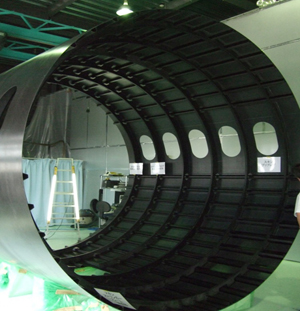Research & Development
JAXA promotes three research and development programs and a fundamental research program that underpins them.
Composite materials technology
-

Fuselage structure manufactured
using the VaRTM-prepreg hybrid method - The Aviation Technology Directorate of JAXA uses various specialized test equipment designed and customized especially for R&D of composite materials. The equipment includes strength test evaluation equipment, physical-properties evaluation equipment, and a nondestructive inspection system. We intend to improve present composite materials and to elucidate unknown points such as their fracture mechanisms. Subsequently, we will conduct research aiming at their application to the property improvement and design of materials, the study of analytical technologies that are indispensable for aircraft design technology, and the demonstration of technologies related to composite materials and structures. We are thereby willing to contribute to the Japanese aerospace industry.
Moreover, we plan to synthesize next-generation composite materials with higher strength and novel function compared to present composite materials. We are particularly addressing R&D for the synthesis of heat-resistant polyimide composites, super heat-resistant inorganic composite materials, ultralight ablators, and nanocomposite materials. Through standardization of the test methods for composite materials as JIS or ISO, and through publishing a composite-material database, JAXA promotes practical usage of composite materials. We are therefore willing to contribute to sustaining and expanding the competitiveness of the Japanese aerospace industry.
Research on multifunctional composite materials
High-performance polyimide composite
We are aiming at improving lightweight, highly heat-resistant, and high-strength polyimide/carbon fiber composite materials to a practical level, and are striving to apply them to high-temperature components such as aircraft engine structures and spacecraft heat-resistant components mainly comprising conventionally used Ti alloys.
Carbon nanotube composite materials
Aiming at the establishment of mass production techniques, improved reliability, and other important objectives, we are conducting R&D related to carbon nanotube composite materials, which are anticipated as novel composite materials that exceed CFRP performance.
Nanocarbon functional composite materials
We are advancing research related to the synthesis of multifunctional composite materials applicable to various fields, not only by combining pure carbon nanotubes (CNT) and graphene into a composite material, but by hybridizing them with other metallic substances to enhance reinforcement properties or to provide novel properties.
Ablation materials
We are developing ablation materials with good productivity and less than half the specific gravity of conventional materials.
SiC/SiC composite materials for aircraft engines
We are aiming at replacing heat-resistant metals used for present aircraft engines with lightweight composite materials offering excellent heat resistance. We are particularly addressing fiber-reinforced composite materials using SiC continuous glass fiber and SiC as a matrix for enhanced strength and cost reduction.
CFRP recycling technology
Through fundamental surveys and investigations related to CFRP recycling technology, we are conducting research on the synthesis of composite materials that are re-applicable to CFRP components from high-performance carbon fiber used for aircraft structures.
Research on innovative application technology of advanced composite materials
Impact penetration test to composite structural members
We are analyzing the damage evolution behavior of composite materials with impact penetration tests to reveal the modes of damage of a composite fuselage structure and its subsequent behavior.
Basic research for application of CFRP to aircraft engines
We are promoting basic research on the high-velocity projectile impact property of CFRP, aiming at its application to aircraft engine fan systems.
Research on the fracture mode of composite materials with a high-speed camera
We are studying the visualization of CFRP fracture behavior using high-speed photography and displacement behavior analysis with high time resolution using the Digital Image Correlation (DIC) method, aiming at clarification of the fracture mechanisms of composite materials and the deformation behavior of materials during fracture.
Interlaminar reinforcement technology of composite materials
Delamination of internal layers in CFRP greatly degrades its compressive strength (after impact) because of its laminated structure. To overcome this problem, we are advancing research on interlaminar reinforcement technologies of composite materials.
Lightning stroke damage to composite materials
We are conducting research on lightning stroke damage to composite materials for improved structural safety of composite materials struck by lightning.
Research on water absorption and electrolytic corrosion of composite materials
Using water absorption tests combined with potential measurements, we are accumulating data related to corrosion protection procedures of CFRP in which an "electrolytic-corrosion" phenomenon occurs when seawater or acid rain permeates a material. We are applying those results to design procedures and operation criteria of a CFRP and lightweight alloy combination structure for the production of aircraft of the future.
Composite material structure in an ultralow temperature environment
We are investigating the development of CFRP cryogenic liquid propellant tanks for the implementation of next-generation rockets, reusable launch systems, and liquid hydrogen aircraft.
Research on long-term durability of composite materials
We are evaluating mechanical properties such as the strength of CFRP after exposure to high-temperature environments or a cold and hot cycle environment to guarantee long-term CFRP durability and excellent reliability.
Demonstration of VaRTM / VPH fabrication technology
We are researching and evaluating new curing methods for CFRP by assessing the VaRTM (Vacuum assisted Resin Transfer Molding) and VPH (VaRTM Prepreg Hybrid) curing method, both of which are less expensive than the traditional autoclave manufacturing method.
Composite material repair techniques for aircraft
We continue to conduct fundamental research to repair the composite-material structures of aircraft safely, reliably, quickly, and at low cost.
Measure towards spread and expansion of composite materials
Standardization of advanced composite materials evaluation technologies and test methods
We are promoting adoption of our CFRP valuation method cultivated to meet JIS or ISO standards, so that our evaluation methods can be used throughout the industrialized world.
Construction of a composite material database
We are disclosing our achievements related to composite material technical research as an advanced composite material mechanical property database (JAXA-ACDB) for assisting the Japanese aerospace industry in its enhancement of global competitiveness.